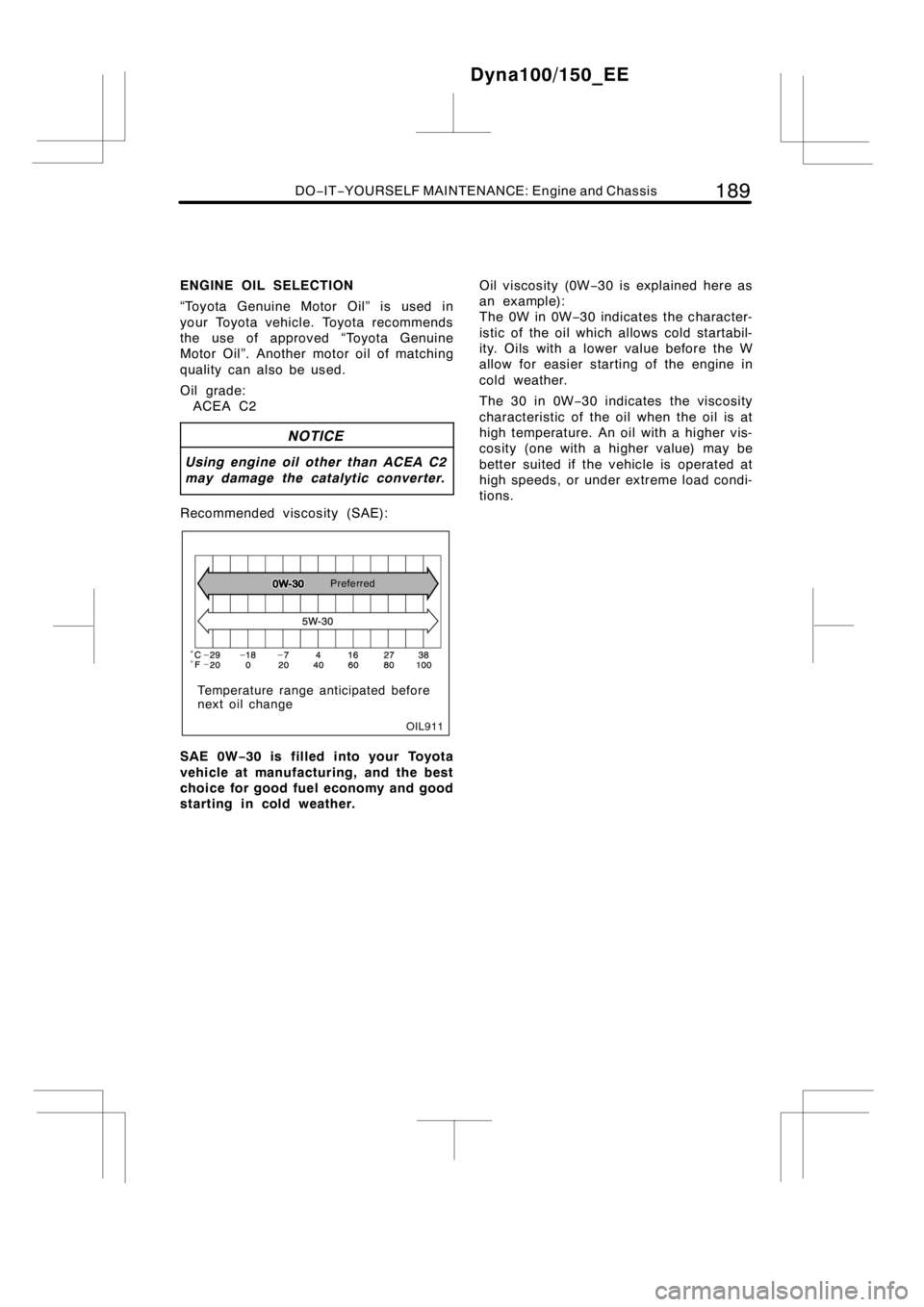2014 TOYOTA DYNA 100/150 oil temperature
[x] Cancel search: oil temperaturePage 73 of 232

GAUGES, METERS AND SERVICE REMINDER INDICATORS67
Section 1−5
OPERATION OF INSTRUMENTS AND
CONTROLS
Gauges, Meters and Service reminder indicators
DFuel gauge 68.........................................
DEngine coolant temperature gauge 68...................
DTachometer 69........................................
DOdometer and two trip meters 70........................
DOil maintenance managementsystem 70................
DService reminder indicators and warning buzzer 73.......
Dyna100/150_EE
Page 119 of 232

INFORMATION BEFORE DRIVING YOUR TOYOTA11 3
NOTICE
To prevent damage to the system and
a fire hazard, observe the following
precautions:
zUse only diesel fuel.
zDo not drive for long periods of
time while the DPF system indicator
light is flashing.
zDo not use fuel other than the spe-
cified type.
zDo not use engine oil other than
the recommended type.
zDo not modify the exhaust pipe.
zOperating the vehicle when the en-
gine oil contains a significant
amount of diesel fuel may result in
damage to the engine. If a signifi-
cant amount of fuel is present,
change the oil as soon as possible.
zDo not drive with an extremely low
fuel level; running out of fuel could
cause the engine to misfire, creat-
ing an excessive load on the cata-
lytic converter.
zDo not pull−or push−start your ve-
hicle.
zDo not turn off the engine switch
while the vehicle is moving.
zKeep your engine switch in good
running order. Malfunctions in the
engine electrical system or fuel sys-
tem could cause an extremely high
catalytic converter temperature.
zIf the engine becomes difficult to
start or stalls frequently, take your
vehicle in for a check−up to any
authorized Toyota dealer or repairer,
or another duly qualified and
equipped professional.
zTo ensure that the catalytic convert-
er and the entire emission control
system operate properly, your ve-
hicle must receive the periodic in-
spections required by the Toyota
Maintenance Schedule. For sched-
uled maintenance information, refer
to the “Toyota Service Booklet” or
“Toyota Warranty Booklet”.
Dyna100/150_EE
Page 121 of 232

INFORMATION BEFORE DRIVING YOUR TOYOTA11 5
FUNCTIONS OF ENGINE OIL
Engine oil has the primary functions of
lubricating and cooling the inside of the
engine, and plays a major role in main-
taining the engine in proper working order.
ENGINE OIL CONSUMPTION
It is normal that an engine should con-
sume some engine oil during normal
engine operation. The causes of oil
consumption in a normal engine are as
follows.
DOil is used to lubricate pistons, piston
rings and cylinders. A thin film of oil
is left on the cylinder wall when a pis-
ton moves downwards in the cylinder.
High negative pressure generated when
the vehicle is decelerating sucks some
of this oil into the combustion chamber.
This oil as well as some part of the oil
film left on the cylinder wall is burned
by the high temperature combustion
gases during the combustion process.
DOil is also used to lubricate the stems
of the intake valves. Some of this oil
is sucked into the combustion chamber
together with the intake air and is
burned along with the fuel. High tem-
perature exhaust gases also burn the
oil used to lubricate the exhaust valve
stems.
The amount of engine oil consumed de-
pends on the viscosity of the oil, the
quality of the oil and the conditions the
vehicle is driven under.
More oil is consumed by high−speed driv-
ing and frequent acceleration and decel-
eration.
A new engine consumes more oil, since
its pistons, piston rings and cylinder walls
have not become conditioned.
Oil consumption:Max. 1.0 L per 1000
km (1.1 qt./600 miles, 0.9 Imp. qt./600
miles)When judging the amount of oil con-
sumption, note that the oil may become
diluted and make it difficult to judge
the true level accurately.
As an example, if a vehicle is used for
repeated short trips, and consumes a nor-
mal amount of oil, the dipstick may not
show any drop in the oil level at all, even
after 1000 km (600 miles) or more. This
is because the oil is gradually becoming
diluted with fuel or moisture, making it
appear that the oil level has not changed.
The diluting ingredients evaporate out
when the vehicle is then driven at high
speeds, as on an expressway, making it
appear that oil is excessively consumed
after driving at high speeds.
IMPORTANCE OF ENGINE OIL LEVEL
CHECK
One of the most important points in prop-
er vehicle maintenance is to keep the en-
gine oil at the optimum level so that oil
function will not be impaired. Therefore, it
is essential that the oil level be checked
regularly. Toyota recommends that the oil
level be checked every time you refuel
the vehicle.
NOTICE
Failure to check the oil level regularly
could lead to serious engine trouble
due to insufficient oil.
For detailed information on oil level check,
see “Checking the engine oil level” on
page 188 in Section 7−2.
Dyna100/150_EE
Facts about engine oil
consumption
Page 135 of 232

STARTING AND DRIVING129
When encountering flooded roads
Do not drive on a road that has flooded
after heavy rain etc. Doing so may cause
serious damage to the vehicle.
NOTICE
Driving on a flooded road may cause
the engine to stall as well as cause
serious vehicle malfunctions such as
shorts in electrical components and
engine damage from water immersion.
In the event that you drive on a
flooded road and the vehicle is
flooded, be sure to have any autho-
rized Toyota dealer or repairer, or
another duly qualified and equipped
professional check brake function,
changes in quantity and quality of oil
and fluid used for the engine, trans-
mission, differential, etc. and lubricant
condition for the propeller shaft, bear-
ings and suspension joints (where
possible) and the function of all joints
and bearings.
Make sure your coolant is properly pro-
tected against freezing.
Only use “Toyota Super Long Life Coolant”
or similar high quality ethylene glycol
based non−silicate, non−amine, non−nitrite,
and non−borate coolant with long−life
hybrid organic acid technology. (Coolant
with long−life hybrid organic acid
technology is a combination of low
phosphates and organic acids.)
See “Checking the engine coolant level”
on page 190 in Section 7−2 for details of
coolant type selection.
“Toyota Super Long Life Coolant” is a mix-
ture of 50% coolant and 50% deionized
water. This coolant provides protection
down to about−35_C(−31_F).
NOTICE
Do not use plain water alone.
Check the condition of the battery and
cables.
Cold temperatures reduce the capacity of
any battery, so it must be in top shape
to provide enough power for winter start-
ing. Section 7−3 tells you how to visually
inspect the battery. Any authorized Toyota
dealer or repairer, or another duly quali-
fied and equipped professional, will be
pleased to check the level of charge.
Make sure the engine oil viscosity is
suitable for the cold weather.
See page 188 in Section 7−2forrecom-
mended viscosity. Leaving a heavy sum-
mer oil in your vehicle during winter
months may cause harder starting. If you
are not sure about which oil to use, call
any authorized Toyota dealer or repairer,
or another duly qualified and equipped
professional—who will be pleased to help.
Dyna100/150_EE
Winter driving tips
Page 154 of 232

148IN CASE OF AN EMERGENCY
If your engine coolant temperature
gauge indicates overheating, if you ex-
perience a loss of power, or if you hear
a loud knocking or pinging noise, the
engine has probably overheated. You
should follow this procedure...
1. Pull safely off the road, stop the ve-
hicle, and turn on your emergency
flashers. Put the transmission in neu-
tral and apply the parking brake. Turn
off the air conditioning if it is being
used.
2. If coolant or steam is boiling out of the
radiator or reservoir, stop the engine.
Wait until the steam subsides before
opening the engine access hole cover
or tilting the cab. If there is no coolant
or steam boiling over, leave the engine
running and make sure the electric
cooling fan is operating. If it is not,
turn the engine switch off.
CAUTION
To help avoid serious injury, keep the
engine access hole cover closed or
the cab lowered until there is no
steam. Escaping steam or coolant is
a sign of very high pressure.
3. Visually check to see if the engine
drive belt (fan belt) is broken or loose.
Look for obvious coolant leaks from the
radiator, hoses, and under the vehicle.
However, note that water draining from
the air conditioning is normal if it has
been used.
CAUTION
When the engine is running, keep
hands and clothing away from the
moving fan and engine drive belts.
4. If the engine drive belt is broken or the
coolant is leaking, stop the engine im-
mediately. Call any authorized Toyota
dealer or repairer, or another duly qual-
ified and equipped professional, for as-
sistance.
5. If the engine drive belt is O.K. and
there are no obvious leaks, you may
help the engine cool down more quickly
by running it at about 1500 rpm for a
few minutes with the accelerator pedal
lightly depressed.
6. Check the coolant reservoir. If it is dry,
add coolant to the reservoir while the
engine is running. Fill it about half full.
For the coolant type, see “Coolant type
selection” on page 191 in Section 7−2.
CAUTION
Do not attempt to remove the radiator
cap when the engine and radiator are
hot. Serious injury could result from
scalding hot fluid and steam blown
out under pressure.
7. After the engine coolant temperature
has cooled to normal, again check the
coolant level in the reservoir. If neces-
sary, bring it up to half full again.
Serious coolant loss indicates a leak in
the system. You should have it
checked as soon as possible at any
authorized Toyota dealer or repairer, or
another duly qualified and equipped
professional.
Dyna100/150_EE
If your vehicle overheats
Page 191 of 232

DO−IT−YOURSELF MAINTENANCE: Introduction185
If you perform maintenance by yourself,
be sure to follow the correct procedure
given in this Section.
You should be aware that improper or in-
complete servicing may result in operating
problems.
This Section gives instructions only for
those items that are relatively easy for an
owner to perform. As explained in Section
6, there are still a number of items that
must be done by a qualified technician
with special tools.
Utmost care should be taken when work-
ing on your vehicle to prevent accidental
injury. Here are a few precautions that
you should be especially careful to ob-
serve:
CAUTION
DWhen the engine is running, keep
hands, clothing, and tools away
from the moving fan and engine
drive belts. (Removing rings,
watches, and ties is advisable.)
DRight after driving, the engine
compartment—the engine, radiator,
exhaust manifold and power steer-
ing fluid reservoir, etc.—will be hot.
So be careful not to touch them.
Oil and fluids may also be hot.
DIf the engine is hot, do not remove
the radiator cap or loosen the drain
plugs to prevent burning yourself.
DDo not leave anything that may
burn easily, such as paper or rags,
in the engine compartment.
DDo not smoke, cause sparks or al-
low open flames around fuel or the
battery. Their fumes are flammable.
DBe extremely cautious when work-
ing on the battery. It contains poi-
sonous and corrosive sulfuric acid.
DDo not get under your vehicle with
just the body jack supporting it. Al-
ways use automotive jack stands or
other solid supports.
DBe sure that the engine switch is
off if you work near the electric
cooling fans. With the engine
switch on, the electric cooling fans
will automatically start to run if the
engine coolant temperature is high
and/or the air conditioning is on.
DUse eye protection whenever you
work on or under your vehicle
where you may be exposed to flying
or falling material, fluid spray, etc.
DUsed engine oil contains potentially
harmful contaminants which may
cause skin disorders such as in-
flammation or skin cancer, so care
should be taken to avoid prolonged
and repeated contact with it. To re-
move used engine oil from your
skin, wash thoroughly with soap
and water.
DDo not leave used oil within the
reach of children.
DDispose of used oil and filter only
in a safe and acceptable manner.
Do not dispose of used oil and fil-
ter in household trash, in sewers or
onto the ground. Call your dealer or
a service station for information
concerning recycling or disposal.
DTake care when filling the brake and
clutch fluid reservoirs because
brake fluid can harm your hands or
eyes. If fluid gets on your hands or
in your eyes, flush the affected area
with clean water immediately. If you
still feel uncomfortable with your
hands or eyes, go to the doctor.
Dyna100/150_EE
Do−it−yourself service
precautions
Page 195 of 232

DO−IT−YOURSELF MAINTENANCE: Engine and Chassis189
ENGINE OIL SELECTION
“Toyota Genuine Motor Oil” is used in
your Toyota vehicle. Toyota recommends
the use of approved “Toyota Genuine
Motor Oil”. Another motor oil of matching
quality can also be used.
Oil grade:
ACEA C2
NOTICE
Using engine oil other than ACEA C2
may damage the catalytic converter.
Recommended viscosity (SAE):
Temperature range anticipated before
next oil change
Preferred
SAE 0W−30 is filled into your Toyota
vehicle at manufacturing, and the best
choice for good fuel economy and good
starting in cold weather.Oil viscosity (0W−30 is explained here as
an example):
The0Win0W−30 indicates the character-
istic of the oil which allows cold startabil-
ity. Oils with a lower value before the W
allow for easier starting of the engine in
cold weather.
The30in0W−30 indicates the viscosity
characteristic of the oil when the oil is at
high temperature. An oil with a higher vis-
cosity (one with a higher value) may be
better suited if the vehicle is operated at
high speeds, or under extreme load condi-
tions.
Dyna100/150_EE
Page 196 of 232

190DO−IT−YOURSELF MAINTENANCE: Engine and Chassis
To ensure excellent lubrication perfor-
mance for your engine, Toyota recom-
mends the use of “Toyota Genuine Motor
Oil”, which has been specifically tested
and approved for all Toyota engines.
Please contact any authorized Toyota
dealer or repairer for further details about
“Toyota Genuine Motor Oil”. Other motor
oils of matching quality also be used.Look at the see−through coolant reser-
voir when the engine is cold. The cool-
ant level is satisfactory if it is between
the “FULL” and “LOW” lines on the
reservoir. If the level is low, add the
coolant. (For the coolant type, see
“Coolant type selection” described be-
low.)
The coolant level in the reservoir will vary
with engine temperature. However, if the
level is on or below the “LOW” line, add
coolant. Bring the level up to the “FULL”
line.
If the coolant level drops within a short
time after replenishing, there may be a
leak in the system. Visually check the
radiator, hoses, radiator cap and drain
cock and water pump.
If you can find no leak, have any autho-
rized Toyota dealer or repairer, or another
duly qualified and equipped professional,
test the cap pressure and check for leaks
in the cooling system.
CAUTION
To prevent burning yourself, do not
remove the radiator cap when the en-
gine is hot.
Dyna100/150_EE
Checking the engine coolant
level